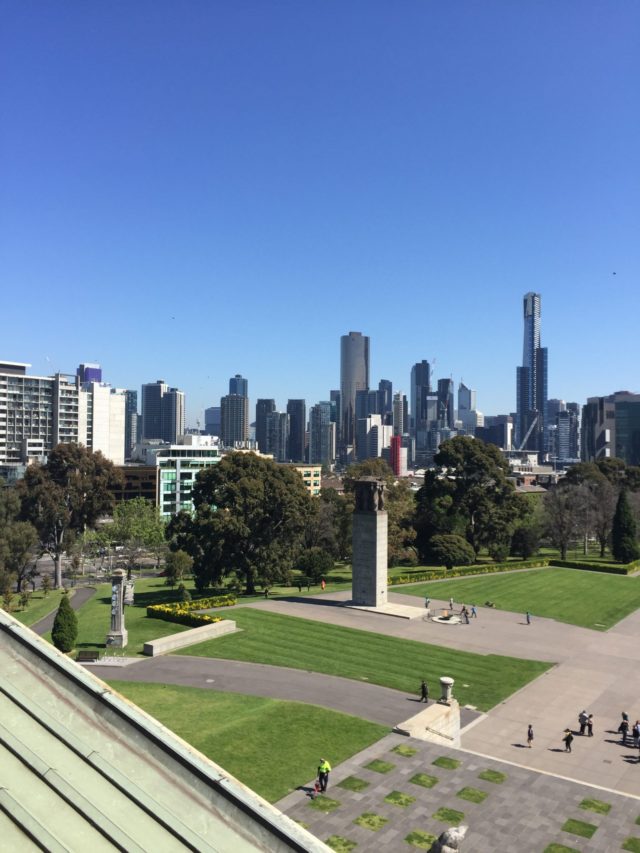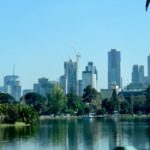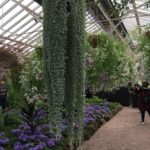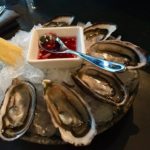The weather gods favored us with another lovely day for our tour of Melbourne.
Our drive through the greater Melbourne area showed what an architecturally diverse city it is. From the impressive skyscrapers and heritage buildings to beautifully landscaped parks and gardens, it’s easy to see why it was recently named the most livable city in the world by Forbes magazine.
Our guide for the next two days, John, drove us around the city and suburbs to give us a feel for the city’s architectural variety, which he attributes to the many universities with engineering schools. This inspires innovative contemporary designs, which exist side by side with historic buildings. In fact, Melbourne strives to preserve its historic buildings; many are what is called heritage overlays, where the façade is kept and the new building goes behind/on top. Here are some examples, including a heritage building flanked by newer ones and two colorful designs. From the skyline photos you can see the varied profiles, as well as the construction cranes that attest to the large amount of building in the city.
Look at the design on this building. Talk about creative! When you get closer to it, you can see how the balcony railings form the lights and darks that make up the face.

You didn’t think I’d let you get by with out at least a few sentences of history and background, did you? The first settlers, led by John Batman, came from Tasmania to the Yarra River Valley in 1837 and founded the city. Some of the cottages they built have now become beachside vacation homes.
Today Melbourne is the largest container port in Australia. The bay is shallow, with one deep shipping channel, and is 10 times the size of Sydney Harbor. The city has a diverse population base, with 4.5 million inhabitants. Italians are the largest group (c. 1.8%), with most coming before WWII. The Greeks followed in the late 1940s; the city is home to the largest Greek population outside of Athens. Many Asians come for the high quality universities. In the 1960s and 1970s, many Vietnamese refugees came to Australia and settled in Melbourne, where the city built large subsidized apartment blocks for them. Today they house immigrants from Eritrea, Ghana, Syria, and other countries.
As a result of the many different immigrant groups, Melbourne has 14 distinct eating areas, including Little Vietnam, Little Italy, and a Greek area.
The cost of living is lower than Sydney; the average home price is about $500,000 Australian. The city attracts about 3,000 new residents each month and is expanding on the outskirts, where there is good land availability.
John drove us out to the wealthy suburb of Brighton, where we saw the colorful Brighton Beach Boxes. These are privately owned beach cabanas, simple 9’ x 12’ boxes with no plumbing or electricity unless you rig up something. Families pass them down from generation to generation. Want to buy one today? It will cost you $300,000! Yes, for this bare wooden box!
On the way back into the city we drove down St. Kilda Road, the Champs Elysées of Melbourne, and through other suburbs to Albert Park, the site of many events during the 1956 Olympics.
Melbourne residents love their gardens, with one on each of the four sides of the city. The Botanical Gardens is home to the Shrine of Remembrance, a World War I memorial built in the 1930s. It is topped by a pyramid-like “dome,” with an impressive interior that doesn’t show up well in photos. (Well, I tried!) The view of the city from the Shrine, the photo at the top of this post, is quite impressive.
Later we saw school children on a field trip. Their uniforms include hats!

In the Fitzroy Gardens, one of the other major parks, we saw what purports to be the oldest building in Australia, the Captain Cook House, home to the famous explorer. However, he never lived in it in Melbourne (and I’m not sure he even explored Melbourne!). It was his childhood home, built in 1755 in the English village of Great Ayton and dismantled, brought to Melbourne, and rebuilt in the Fitzroy Gardens in 1934! We watched a group of girls having fun trying on the period costumes and taking photos of themselves.
Also in the Fitzroy Gardens is the lovely Conservatory, with gorgeous orchids and Japanese Maples, among other specimens. We wished our poor little maple could look half as good….
John also showed a few areas in the city where graffiti–er, street–artists can paint on the walls. Their work was creative and unusual, to say the least!
All this sightseeing made us hungry, so at John’s suggestion we walked over to Flinder’s Lane, not far from the hotel, to find a place for lunch. Jing Jai Thai looked promising, as it was packed with diners, and we were not disappointed. Look at this fresh spring roll, Don’s Tom Yum Soup, and our shared Drunken Noodles.
After our late lunch and a lazy afternoon, we opted for a light dinner at the Oyster Bar of the Atlantic Seafood Restaurant in the Crown complex. Don was especially happy with the $2 oysters, and that for the first time since arriving in Australia they were served on ice. My grilled giant prawns were equally tasty.
On the way back from dinner, we wandered through the huge casino which is part of the complex. The tables on the main level started at $50, and there were plenty of $100 and up tables as well—all full. Don wanted to gamble a bit to pay for our trip, or so he said….We went two escalators down from the main casino level to find “his” kind of blackjack table – namely, a $5 table. Their blackjack is quite different from Las Vegas. We didn’t even begin to understand all of the rules. Called Blackjack Plus, the plus means the dealer doesn’t bust until 22. Talk about favoring the house! We easily found a vacant table with a very, very nice dealer who helped us lose our entire stake ($20 Australian, $15 US). However, we had fun for half an hour…even if we didn’t contribute towards the trip.
Hope my overview of Melbourne provided some insight into why it rates so high on livability! It’s a lovely city, more laid back than Sydney yet still cosmopolitan.
































Really enjoyed your description and pictures of Melbourne. The interior of that beach house doesn’t even look comfortable. Maybe one just tracks in sand and changes clothes.
That’s about it, Lois! It was being renovated; I assume in the season people have beach chairs and such in them.
Wow!!!! Am still reeling from the $300,000.00 beach box. ? As alwats, great narrative and fabulous photos. Thank you for sharing. Hugs
Yes, makes you wonder why they are considered so valuable!
My favorite one. Thought there might not be any food but of course you saved it for the end.
If you are interested in brown pearls or other pearls, there are some great buys depending on the exchange. Major hugs, Jill
Thanks for the tip…but we left Melbourne Oct. 18! I”m way behind, it continues to be difficult blogging on the iPad. I just might have to treat myself to a small laptop….
FUN TO LEARN ABOUT MELBOURNE. THANKS!
It’s such a lovely place, Suzanne.
Great post Marlene. Melbourne does look like an interesting and lovely city.
You’d love it, Linda.